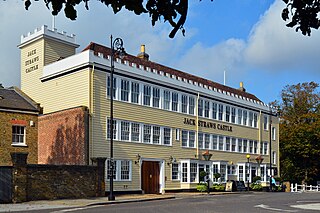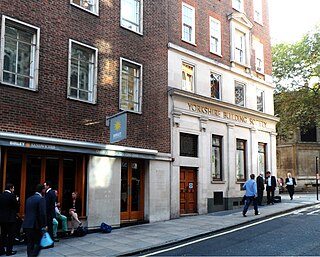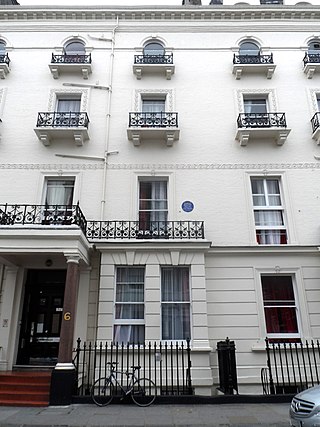
Strand is a major thoroughfare in the City of Westminster, Central London. The street, which is part of London's West End theatreland, runs just over 3⁄4 mile (1.2 km) from Trafalgar Square eastwards to Temple Bar, where the road becomes Fleet Street in the City of London, and is part of the A4, a main road running west from inner London.

St Andrew-by-the-Wardrobe is a Church of England church located on Queen Victoria Street, London in the City of London, near Blackfriars station.

Dr Johnson's House is a writer's house museum in London in the former home of the 18th-century English writer and lexicographer Samuel Johnson. The house is a Grade I listed building.

Gresham Street in the City of London is named after the English merchant and financier Thomas Gresham.
Doughty House is a large house on Richmond Hill in Richmond, London, England, built in the 18th century, with later additions. It has fine views down over the Thames, and both the house and gallery are Grade II listed buildings. This view from Richmond Hill is the only view in England protected by an Act of Parliament.

Jack Straw's Castle is a Grade II listed building and former public house on North End Way, Hampstead, north-west London, England close to the junction with Heath Street and Spaniards Road.

Rathbone Place is a street in central London that runs roughly north-west from Oxford Street to Percy Street. it is joined on its eastern side by Percy Mews, Gresse Street, and Evelyn Yard. The street is mainly occupied by retail and office premises.

Charles Sonnhammer was the owner, with Emil Loibl, of the London Pavilion music hall. In 1872 they established an "oyster warehouse" at 18 Coventry Street. It stood on the corner with Great Windmill Street. Sonnhammer became the sole owner in 1875 following the break up of his partnership with Loibl in 1874. The business changed ownership again in 1876 and once more in 1891 when it became known as Scott's Oyster and Supper Rooms, located at numbers 18 and 19.

Clarges Street is a street in the City of Westminster, London. The street runs from Clarges Mews in the north to Piccadilly in the south. It is crossed by Curzon Street.

Mayfair Place is a street in the City of Westminster, London. The street joins Stratton Street to Berkeley Street.

Craven Street is a street in the City of Westminster, London, England, near The Strand. Several notable historical figures have lived in the street which was the home of Benjamin Franklin, when he lived in London before the American Revolution.

Crawford Street is a street in the Marylebone district of the City of Westminster, London. The street contains two grade II listed public houses.

Essex Street is a street in the City of Westminster that runs from Milford Lane in the south to Strand in the north. It is joined by Little Essex Street on its western side and Devereux Court on the eastern side. It was laid out by Nicholas Barbon in around 1675 or 1680 and contains a number of listed buildings.

The Cheshire Cheese is a public house at 5 Little Essex Street, London WC2, on the corner with Milford Lane.

The Edgar Wallace is a public house at 40–41 Essex Street, London WC2, at the corner with Devereux Court.

Milford Lane is a narrow street in the City of Westminster that runs from Strand in the north to a brief walkway section leading to Temple Place in the south. It is joined by Little Essex Street and Essex Street on its eastern side. Maltravers Street once joined the lane to Arundel Street, but ceased to exist when building work at 190 Strand was completed.

Grenville Place is a street in the Royal Borough of Kensington and Chelsea, London, that connects Cornwall Gardens and Launceston Place in the north with Cromwell Road in the south. It is crossed in its northern part by Cornwall Mews South, and joined on its western side by Emperor's Gate (twice). it is joined on its eastern side by Southwell Gardens.

Markham Square is a garden square in Chelsea, London. It was laid out in 1836. The square is accessed from the King's Road.

Buckingham House was a residence of the Dukes of Buckingham and Chandos in Pall Mall, London. Designed by the Neoclassical architect Sir John Soane in 1790, it featured the Neo-Palladian style for the three-storey-high frontage. The construction work finished in 1795.




















